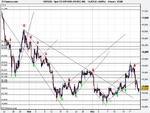megamuel
Experienced member
- Messages
- 1,098
- Likes
- 164
OK, so... Working on my swing trading strategy which I'm hoping to put into action early next year. I've got my entry criteria, I know where to put my initial stop loss and I know how to calculate my trade size (2% of capital divided by number of points between entry and stop loss). Now I need to know how to exit a profitable trade (wishfull thinking!!!). I know there is no straight forward answer to this, I'm just after some guidance... So (I think) I have 3 options:
1. Wait for the reason the trade was entered to change and exit. E.g. Stochastic is one of the indicators I am using, if short trade is entered when overbought, wait until oversold to exit. PRO - Easy to know when to exit. CON - Oscillators are not accurate and do not predict future price action, might miss some profit.
2. Set a limit order at 2 or 3 times the risk. PRO - Can be done when trade is enetered and means that continual monitoring will not be required, simply wait for one of the orders to be hit. CON - As with #1 the trade could potentially go to more than 3x risk!
3. Use a trailing stop or manually adjust stop as trade becomes more profitable. PRO - could potentially catch large profits from trades that go to many times the size of the inital risk. CONS - Constant monitoring of all trades would be necessary and stop adjusted accordingly... Price could come down hit stop if too tight and then go off into profit or if a looser stop was used, some potential profit could be lost if trend reverses.
Any thoughts/guidance would be much appreciated. Thought I saw a similar thread a while back but could not find it. Thanks all, hope everyone is well.
Sam.
1. Wait for the reason the trade was entered to change and exit. E.g. Stochastic is one of the indicators I am using, if short trade is entered when overbought, wait until oversold to exit. PRO - Easy to know when to exit. CON - Oscillators are not accurate and do not predict future price action, might miss some profit.
2. Set a limit order at 2 or 3 times the risk. PRO - Can be done when trade is enetered and means that continual monitoring will not be required, simply wait for one of the orders to be hit. CON - As with #1 the trade could potentially go to more than 3x risk!
3. Use a trailing stop or manually adjust stop as trade becomes more profitable. PRO - could potentially catch large profits from trades that go to many times the size of the inital risk. CONS - Constant monitoring of all trades would be necessary and stop adjusted accordingly... Price could come down hit stop if too tight and then go off into profit or if a looser stop was used, some potential profit could be lost if trend reverses.
Any thoughts/guidance would be much appreciated. Thought I saw a similar thread a while back but could not find it. Thanks all, hope everyone is well.
Sam.

